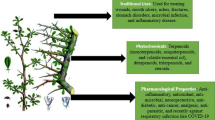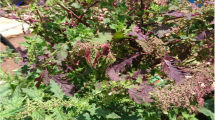Abstract
There are several described medicinal plants in Kenya from a flora of approximately 10,000 members. Strong cross-medical information from the 42 ethnic groups points to the high potential of some of these species. The Myrsinaceae are well established ethno-anthelmintics and anti-bacterials. They are harbingers of long alkyl side chain benzoquinones which clearly have a protective function from their histochemical disposition. The main benzoquinone in the sub-family Myrsinodae is embelin while for the Maesodae it is maesaquinone together with its 5-acetyl derivative; the distribution of these benzoquinones by their alkyl side chain length or the presence/absence of a 6-methyl group is in accord with morphological sub-family de-limitation. The benzoquinones showed anti-feedant, anti-microbial, phytotoxic, acaricidal, insecticidal and nematicidal activity. Many other benzoquinones of medium and minor concentration were also isolated and characterised. Some plants belonging to the Polygonaceae which are widely used as ethno-anthelmintics have been studied. The common anthelmintic anthraquinones were obtained from all five Rumex species while the naphthalenic acetogenin derivative, nepodin was more selectively distributed. The leaf of Polygonum senegalense is up to 17% surface exudate; about thirteen non polar flavonoid derivatives (chalcones, dihydrochalcones, flavanones and a flavone) have been isolated from it. From the internal aerial tissues of this plant, the major flavonoids were common flavonoids, quercetin, kaempferol, luteolin and their glycosides. The only unique compound isolated from this plant was 2′-glucosyl-6′-hydroxy-4′-methoxydihydrochalcone whose aglycone, uvangolatin is part of the exudate mixture. Other leaf exudate plants studied include the stomach-ache medicine, Psiadia punctulata (Compositae) from which novel methylated flavonoids, kaurene and trachyloban diterpenes have been found.
Similar content being viewed by others
References
Abu Zaid MM, El-Karemy Z, El-Negoumy SI, Altosar I & Salel NAM (1991) The flavones of psiadia punctulata. Bull. Chem. Soc. Ethiop. 5: 37–39.
Agnew ADQ & Agnew S (1994) Upland Kenya Wild Flowers. East Africa Natural History Society, Nairobi, 66.
Al-Yahya MA, Hifnawy MS, Mossa JS, El-Feraly FS & McPhail DR (1987) X-ray structure of Psiadiarabin, a flavone from Psiadia arabica. Phytochemistry 26 (9): 2648–2652.
Arora RB, Ghatak N & Gupta PS (1971) Anti-fertility activity of Embelia ribes. J. Res. Indian Med. 6(2): 107–110.
Beentje H (1994) Kenya Trees, Shrubs and Lianas. National Museum of Kenya, Nairobi.
Bhatnagar SS, Santapau H, Desa JDH, Mamar AC, Ghadielly NC, Solomon MJ, Yellore S & Rao TNS (1961) Biological activity of Indian medicinal plants: Part I. Anti-bacterial, anti-tubercular, and anti-fungal action. Indian J. Med. Res. 49(5): 799–813.
Butterworth JA & Morgan ED (1971) Investigation of the locust feeding inhibition of the seeds of the neem tree, Azadirachta indica. J. Insect. Physiol. 17: 969–977.
Chander H & Ahmed SM (1985) Efficacy of natural Embelin against the Red Flour Beetle, Tribolium castaneum (Herbst). J. Stored Prod. Res. 6 (2): 217–220.
Chander H & Ahmed SM (1989) Comparative evaluation of fungicidal quinones and natural embelin against some insect pests of storage. J. Stored Prod. Res. 25(2): 87–91.
El-Dormiaty MMJ, El-Feraly FS, Mossa JS & McPhail AT (1993) Diterpene and a flavone from Psiadia arabica Phytochemistry 31 (8): 2863–2866.
El-Feraly FS, Mossa JS, Al-Yahya MA, Hifnewy MS & Hafez MM (1990) Two flavones from Psiadia arabica. Phytochemistry 29 (10): 3372–5.
Gikonyo NK (1991) Hydrophilic flavonoid compounds of the leaves and flower heads of Polygonum senegalense and the larvicidal and anti-feedant activities of its hydrophobic principles, MSc thesis, University of Nairobi.
Githui EK, Makawiti DW & Midiwo JO (1991) Changes in testosterone, luteinising hormone and progesterone associated with administration of embelin. Contraception 44 (3): 311.
Halliday P (1984) Myrsinaceae. In: RM Polhill (ed.) ‘Flora of Tropical East Africa’, AA Balkema, Rotterdam.
Juma BF, Yenesew A, Midiwo JO & Waterman PG (2001) Flavones and phenylpropanoids in surface exudate of Psiadia punctulata. Phytochemistry 57: 571–574.
Kokwaro JO (1976) Medicinal Plants of East Africa. East African Publishing Bureau, Nairobi.
Makawiti DW & Midiwo JO (1991) The effect of maesaquinone on Plasma testosterone levels in the rabbit. Adv. Contr. Deliv. Syst. VII: 253.
Midiwo JO & Rukunga GM (1985) Distribution of anthraquinone pigments in Rumex species of Kenya. Phytochemistry 24: 1390.
Midiwo JO, Arot LA & Mbakaya L (1988) Distribution of benzoquinones in Kenyan Myrsinaceae. Bull. Chem. Soc. Ethiop. 2(2): 83–85.
Midiwo JO, Matasi JJ, Wanjau OM, Mwangi RW, Waterman PG & Wollenweber E (1990) Anti-feedant effects of surface accumulated flavonoids of Polygonum senegalense Bull. Chem. Soc. Ethiop. 4 (2): 123–127.
Midiwo JO, Ghebremeskel Y, Arot CM, Kayawa K & Natori S (1992a) Benzoquinones in Kenyan Myrsinaceae Part III: A new 2,3-dihydroxyalkyl-1, 4-benzoquinone (myrsinone) and 5–0-methylembelin from Myrsine africana. Bull. Chem. Ethiop. 6 (1): 15–19.
Midiwo JO, Gikonyo NK, Wanjau DO, Matasi JJ, Waterman PG (1992b) Flavonoids of Polygonum senegalense (Meisn) Part II: More surface and internal tissue flavonoid aglycones. Bull. Chem. Soc. Ethiop. 6 (2): 119–122.
Midiwo JO & Ghebremeskel Y (1993) Biembelin-A new symmetrical bisbenzoquinone from Rapanea melanophloeos. Bull. Chem. Soc. Ethiop. 7 (1): 67–69.
Midiwo JO, Owino NO & Dagne E (1994) Flavonoids of Polygonum senegalense Part III: Isolation of dihydrochalcone glucoside and quercetin glycosides. Bull. Chem. Soc. Ethiop. 8 (2): 79–84.
Midiwo JO, Mwangi RW & Ghebremeskel Y (1995) Insect antifeedant, growth-inhibiting and larvicidal compounds from Rapanea melanophloeos (Myrsinaceae). Insect Sci. Appl. 16 (2): 163–166.
Midiwo JO & Arot LM (1996) New dialkyl benzoquinones from fruits of Myrsine africana L and Maesa lanceolata Forsk. Natural Prod. Lett. 8: 11–14.
Midiwo JO, Owuor EAO, Juma BF & Waterman PG (1997) Diterpenes from the leaf exudate of Psiadia punctulata. Phytochemistry 45 (1): 117–120.
Mossa JS, El-Domiaty MM, Al-Mashal IA, El-Feraly FS, Hufford CD, McPhail DR & McPhail AT (1992) A flavone and diterpene from Psiadia arabica. Phytochemistry 31: 2863–2868.
Ogawa H & Natori S (1968) Hydroxybenzoquinones from Myrsinaceae plants II. Distribution among Myrsinaceae plants in Japan. Phytochemistry 7: 773–782.
Rhoades DF (1977) Integrated anti-herbivore, anti-desiccant and ultra-violet screening of creosote bush resin. Biochem. System. Ecol. 5: 281–290.
Watt JM & Breyer-Brandwijk MG (1962) The Medicinal and Poisonous Plants of Southern and Eastern Africa. E.S. Livingstone Ltd., Edinburgh and London, 861 pp.
WHO (1978) The Promotion and Development of Traditional Medicine.
WHO Technical Report Series, n° 662.
Wollenweber E (1986) Flavonoid aglycones as leaf exudate constituents of in higher plants. In: L Farkas, M Gabor & F Kallay (eds), Flavonoids and Bioflavonoids 1985 (pp. 155–169). Elsevier, Amsterdam.
Wollenweber E (1988) Occurrence of flavonoid aglycones in medicinal plants. In J. Allan (ed.) Plant Flavonoids in Biology and Medicine II: Biochemical, Cellular and Medicinal Properties (pp. 45–55). A, Riss Inc. London.
Author information
Authors and Affiliations
Rights and permissions
About this article
Cite this article
Ogweno Midiwo, J., Yenesew, A., Juma, B. et al. Bioactive compounds from some Kenyan ethnomedicinal plants: Myrsinaceae, Polygonaceae and Psiadia punctulata . Phytochemistry Reviews 1, 311–323 (2002). https://doi.org/10.1023/A:1026029609500
Issue Date:
DOI: https://doi.org/10.1023/A:1026029609500




